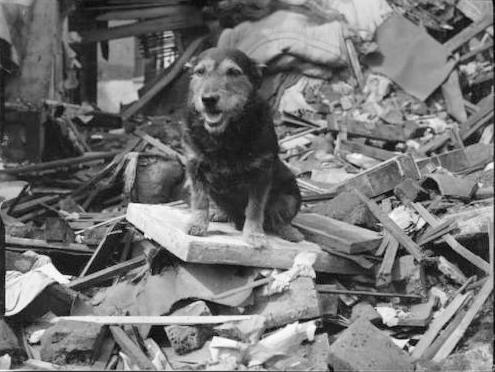
World War II Weapons: Animals -- Pets

Figure 1.--Large numbers of British pet owners had their beloved family pet euthenized after the declaration of war, fearing that they would be unable to feed and care for them. Many other kept their pets. Here a pooch during the London Blitz sits seemingly unfazed amid the ruins of the family home. W are not sure if the fmily survived.
and
|
|
The issue of pets during the War is one of the many sad consequences of the conflict. Here we are taking about both pets kept by the soldiers and the much larger number kept by civilians. Besides their utilitarian purposes, a small number of amimals were also kept as pets by the soldiers. Here we are mostly taling about dogs which provide comfort for men spending years away from family and friends. Perhaps the most famous dog of the war was Ant, a German sheperd rescued by a Czech aviator flying with the British. Bobert Bozdech, Czech airman, was shot down in France during the German invasion. He came across an abndoned German shepherd puppy. He named him Ant and they began a dangerous treck to get to Britain. Their biographer writes, "The house now secured, it was time to get Pierre. The question was what to do with his newfound friend? Robert could hardly deposit him behind the chair again, for knowing puppies as he did, this one would likely start whining just as soon as he had disappeared. It was critical that he keep the liitle ball of fur happy and quiet, at least for now. He unzipped the front of his leather bomber jacket, slipped the puppy inside, and zipped it closed again." [Lewis] Bozdech and Ant made it safely to Britain and begn flying with RAF Bomber Command. Together they survived crash landings and parachute bailouts. Ant would ultimately save Boizdech's life. By the end of the War, Ant was a British war hero. The much larger number of pets were of course kept by civilians. Several of the major belligrant countries had populations with large numbers of pet owners. None of the belligerant powers as rartioning had to be introduced made ration allocations for pets. To the extent that the issue was considered, it was generally thought that that euthanasia was the most humane aooroach rather than watching a chrished pet die slowly and painfully from starvation or disease. Britain had the strongest pet ownership tradition. Large numbers of family pets were eutenized when war was declared. There wre also small animals children kept in their school classes. As the war exppanded, country after country was faced with this painful issue. Another problem was the bombing of civilian areas. There was a shortage of public bomb shelters. And pets were not permitted. And even those who attempted to save their pets, often when faced with food shortages and even starvation, had no choice but to kill and eat their treasured animals. This might mean horses and donkies in rural areas. In the cities it mean dogs and cats.
Sources
Lewis, Damien. The Dog Who Could Fly: The WWII Puppy Who Took To the Skies (2014), 304p.
Ryan, Cornelius. The Last Battle (1966).
CIH

Navigate the Boys' Historical Clothing Web Site:
[Return to Main World War II animal page]
[Return to Main World War II land weapons page]
[Return to Main World War II technology/tactics page]
[Return to Main World War II page]
[Biographies]
[Campaigns]
[Children]
[Countries]
[Deciding factors]
[Diplomacy]
[Geo-political crisis]
[Economics]
[Home front]
[Intelligence]
[POWs]
[Resistance]
[Race]
[Refugees]
[Technology]
[Totalitarian powers]
[Bibliographies]
[Contributions]
[FAQs]
[Images]
[Links]
[Registration]
[Tools]
[Return to Main World War II page]
[Return to Main war essay page]
[Return to CIH Home page]
Created: 2:54 AM 7/19/2017
Last updated: 2:54 AM 7/19/2017



